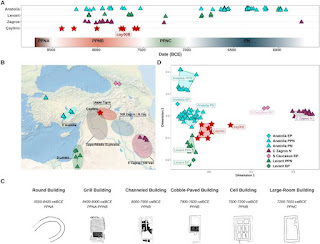Neolithic sites in South Caucasus (except Western Georgia), also known as Shulaveri culture.
We have a sample from Menteshe tepe near modern Armenian border. It plot close Armenians, especially those from Urfa. We have also samples from Hajji Firuz Chalcolithic. It's not considered as part of Shulaveri culture but do have some connection with them, which indeed is visible in their DNA. Soon we will have the G25 coordinates of Armenia Neolithic from Aknashen. In most likelihood it will be similar to samples mentioned above. Or will be slightly western shifted.
The paper below speaks about similar Neolithic sites in South East Turkey around Van region. But given that they had painted pottery archaeologists don't classify them as Shulaveri.
It's now known that Shulaveri folk crossed Caucasus and had presence in North East of Caucasus also. They almost certainly had contacts with local Steppe Piedmont foragers. In Late Chalcolithic period we see some of those Northern women in Areni cave.
Recently a new Neolithic site was found in Armenia. Near Talin, Lernagog. Radiocarbon dating showed that it was the oldest site in SC of this type. ~7000bc.
We have also samples from Çayonu (near Diyarbekir ). At last one of that samples (cay008) seems to be close to those farmers who lived in SC and historic Armenia. While others are close to Anatolia-Levantine clusters. Reich mentioned them in relation to Armenia and Cyprus Neolithic saying:
"We report the first ancient DNA from the world’s earliest farming cultures of southeastern Anatolia and northern Mesopotamia, as well as the first Neolithic period data from Cyprus and Armenia, and discover that it was admixture of Natufian-related ancestry from the Levant—mediated by Mesopotamian and Levantine farmers, and marked by at least two expansions associated with dispersal of pre-pottery and pottery cultures—that generated a pan-West Asian Neolithic continuum."
Whether there was a mass migration of farmers or migration of ideas from Diyarbekir to Araratian plain is unclear given that we don't have Mesolithic DNA from Armenia and Azerbaijan. But there is little doubt that cultural connections existed. Shulaveri farmers were making similar round houses as those in early Çayonu layers. This round architecture was prominent in later Halaf culture also.
Finally we can add that those Central farmers were the first who started to use copper which is abundant in mountains. They shifted to Copper Age starting from 5300bc. One of the earliest shift in West Asia and world. This innovation gived them extra competitive advantages. Which permited them to expand in various directions. The legacy of those expansions is visible in modern populations living in West Asia and neighboring regions.






No comments:
Post a Comment